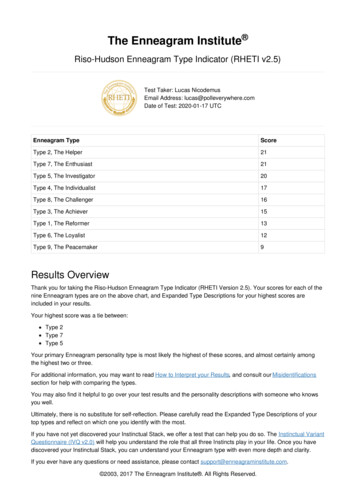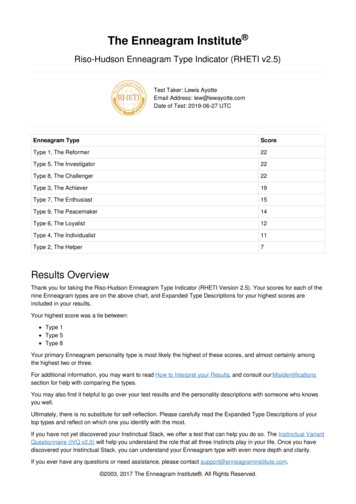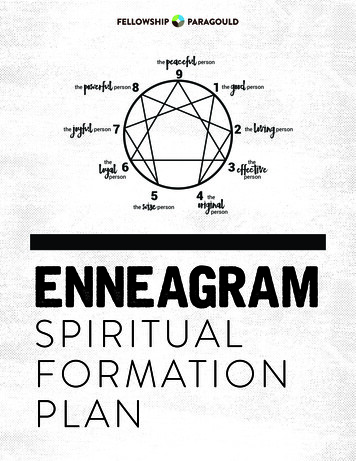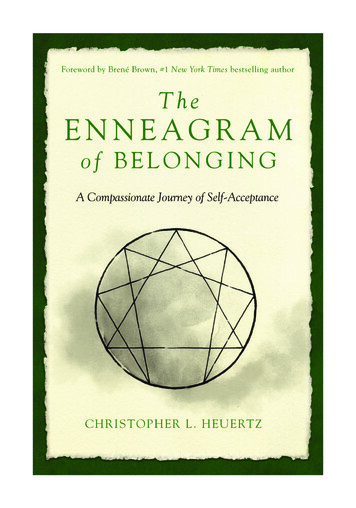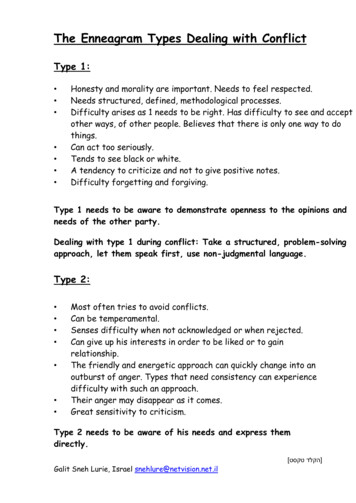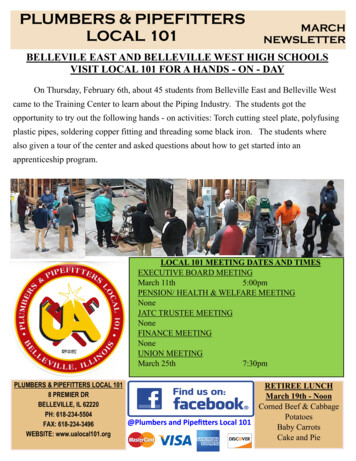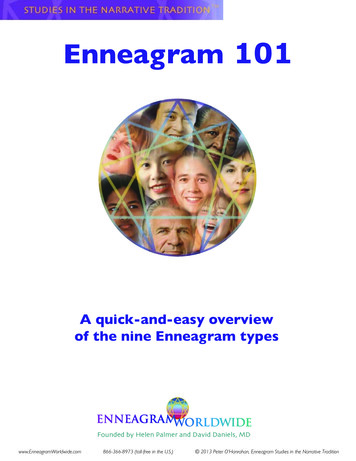
Transcription
Enneagram 101A quick-and-easy overviewof the nine Enneagram typesFounded by Helen Palmer and David Daniels, MDwww.EnneagramWorldwide.com866-366-8973 (toll-free in the U.S.) 2013 Peter O’Hanrahan, Enneagram Studies in the Narrative Tradition
3INTRODUCTIONTHE ENNEAGRAM is a system of ninepersonality types that combines traditionalwisdom and modern psychology into apowerful tool for understanding ourselvesand the people in our lives.The Enneagram describes the strengths andpotentials of each personality type as well asits problems. All personality types are equal,and the highs and lows of human developmentcan be found in every type. While most peopleknow the Enneagram as a profound system ofpersonal or spiritual growth, in recent years italso has been adapted for use in the classroomand in business. In addition to providing crucial“people skills,” the Enneagram supportsself-awareness, good decision-making andcontinual learning, which is vital for successin today’s workplace.One idea underlying the Enneagram is thatpeople have two important aspects – essenceand personality. Each person has a unique“essential self” that can’t be reduced to acategory or a number. However, the Enneagramdescribes nine patterns or themes by whichpeople form a personality, and a social persona,to meet the challenges of love and work.Ideally, personality is an effective way toexpress ourselves in the world. But problemsarise when personality covers up the inner self,or our point of view becomes stuck and rigid.www.EnneagramWorldwide.com866-366-8973 (toll-free in the U.S.)THE NINEENNEAGRAMTYPES1. THE PERFECTIONIST2. THE GIVER3. THE PERFORMER4. THE ROMANTIC5. THE OBSERVER6. THE LOYAL SKEPTIC7. THE EPICURE8. THE PROTECTOR9. THE MEDIATOR 2013 Peter O’Hanrahan, Enneagram Studies in the Narrative Tradition
4BENEFITSWorking with the Enneagram can helpus become more successful in our relationshipsat home and at work.BYBy understanding our own patterns, automaticreactions and blind spots, we can be moreflexible and skillful with the people in our lives.When we understand what others are thinkingand feeling, we become more tolerant andcompassionate. (It also helps us not to takeother people’s negative reactions or hostilityso personally.)PATTERNS,By identifying the psychological and emotionaldefenses specific to our type, the Enneagramcreates opportunities for profound personalgrowth and healing. At yet another level, itoffers a path for developing an inner life andopening to the presence of Spirit within us.UNDERSTANDINGOUR OWNAUTOMATICREACTIONSAND BLINDSPOTS, WE CANBE MOREFLEXIBLE ANDSKILLFUL WITHTHE PEOPLEIN OUR LIVES.We offer a unique and personally transformativeexperience of the Enneagram through ourEnneagram Studies in the NarrativeTradition, founded by Helen Palmer andDavid Daniels, MD. The Narrative Tradition isan extraordinary teaching method that offers aunique and personally transformative experienceof the Enneagram. As you learn about the nineEnneagram types and witness representatives ofeach type sharing their personal stories, you willgain self-awareness, compassion and insights tocreate a more fulfilling and meaningful life.www.EnneagramWorldwide.com866-366-8973 (toll-free in the U.S.) 2013 Peter O’Hanrahan, Enneagram Studies in the Narrative Tradition
5THE THREE CENTERSOF INTELLIGENCEThe Enneagram describes three centers ofintelligence and perception: head, heart andbody. While all of us have all three centers,our personality type has a particular strengthand “home base” in one of them.Understanding our primary center gives us animportant key to developing our personal andprofessional potential and overcoming ourblind spots.THEINTELLECTUALCENTERThinking-based typeslead with ideas,perception andrational thinking.They emphasizegathering informationand figuring thingsout before acting.Their focus is oncreating certaintyand safety, or findingmultiple options.5 - The Observer6 - The Loyal Skeptic7 - The RFeeling-based typesemphasize the heartfor positive andnegative feelings,empathy, and concernfor others, romanceand devotion. Theirfocus is on successand relationship,performing up toexpectations of thejob or other people.2 - The Giver3 - The Performer4 - The Romantic866-366-8973 (toll-free in the U.S.) Body types(instinct) Thinkingtypes(intellect) Feelingtypes(emotion) THEINSTINCTUALCENTERBody-based typeslead with the bodyfor movement, sensateawareness, gut-levelfeelings, personalsecurity and socialbelonging. Their focusis on being in controlof themselves andtheir environment,and taking actionin practical ways.8 - The Protector9 - The Mediator1 - The Perfectionist 2013 Peter O’Hanrahan, Enneagram Studies in the Narrative Tradition
6ENNEAGRAM TYPE ONE:THE PERFECTIONISTOnes are a body-based type with anemphasis on personal integrity and self-control.Their attention goes toward seeing andcorrecting what is wrong, and doing the rightthing. They are known for their honesty,dependability and common sense.Ones are responsible, so much so that theymay resent other people who do not takelife as seriously as they do. They have highstandards and tend to see the world in blackand white, right and wrong. It’s easy for themto be critical, of themselves as well as others.They work hard at being right all the time.They are idealistic and will exert great effortto improve the world around them, whichoften puts them in the role of social reformer.Their crucial elements of growth are to learnto accept their imperfections and tolerateother people’s points of view.Speaking style: Precise and detail-oriented,with a tendency to sermonize or preach.Lower emotional habit: Resentment,which comes from getting angry, but holdingit in.Higher emotion: Serenity, which comeswith letting go of anger about the way thingsare and accepting 3 (toll-free in the TEDPROBLEMS:RESENTFUL,NON-ADAPTABLEAND OVERLYCRITICALARCHETYPALCHALLENGE:TO CHANGEWHAT CANBE CHANGED,TO ACCEPTWHAT CANNOTBE CHANGEDAND TO DEVELOPTHE WISDOMTO KNOW THEDIFFERENCE 2013 Peter O’Hanrahan, Enneagram Studies in the Narrative Tradition
7ENNEAGRAM TYPE TWO:THE GIVERTwos are a feeling-based type witha focus on relationship. They excel at makingconnections and empathizing with the needsand feelings of other people. Usually good atsupporting others and helping bring out theirpotential, Twos find turning their attentiontoward themselves and their own needs muchmore difficult.They want to be accepted and liked byothers, and will adapt or change to earn thisapproval. Emotionally sensitive, Twos need to bevery careful what they absorb from the peoplearound them. Setting personal boundariescan be challenging, although they may haveemotional outbursts to relieve the pressure.While being a special person or earning theapproval of others has its advantages, it doesn’tsubstitute for being loved for oneself.Speaking style: Being nice and sympathetic,giving advice, sometimes militant for the cause.STRENGTHS:CARING, POPULAR,COMMUNICATORPROBLEMS:PRIVILEGED, NAIVE,DEPENDENTARCHETYPALCHALLENGE:TO FIND ONESELFIN RELATIONSHIP,BALANCINGDEPENDENCYAND AUTONOMYLower emotional habit: Pride aboutbeing special, important or indispensable inrelationship, poor self-esteem when approvalis not forthcoming.Higher emotion: Humility, which is beingable to know and hold on to the experienceof self-worth without either self-inflation orexcessive judgment.www.EnneagramWorldwide.com866-366-8973 (toll-free in the U.S.) 2013 Peter O’Hanrahan, Enneagram Studies in the Narrative Tradition
8ENNEAGRAM TYPE THREE:THE PERFORMERThrees are a feeling-based type whochannel their emotional energy into gettingthings done. They take the initiative andwork hard to accomplish their goals. Highlyadaptable, they excel at “feeling out” andmeeting the expectations of others when thatwill lead them to success.Threes like to stay active and on the go, so theyfind it hard to stop or slow down. Their focuson keeping up their image and achieving resultscan get in the way of personal needs and health.In American business, a particularly strongThree culture, performers get a lot ofpositive reinforcement for being productiveand efficient.A danger for Threes is concentrating onexternal praise or material rewards while losingcontact with who they are inside. It’s difficultfor them to step out of their roles, feel theirown feelings, and decide for themselves whatis important.Speaking style: Enthusiastic, motivatingthemselves and others for success.Lower emotional habit: Vanity, basedon keeping up a good image and always beingsuccessful.Higher emotion: Truthfulness, which isthe willingness to go beyond appearancesand develop personal 3 (toll-free in the U.S.)STRENGTHS:SUCCESSFUL,ENERGETIC,HIGH RCHETYPALCHALLENGE:TO LET GO OFIMAGE ANDSOCIAL PERSONAAND FINDONE’S INNERESSENCE 2013 Peter O’Hanrahan, Enneagram Studies in the Narrative Tradition
9ENNEAGRAM TYPE FOUR:THE ROMANTICFours are a feeling-based type whooften experience a sense of longing or melancholy.Something is missing for them, which can lead tofeelings of envy. They seek meaning and depth intheir relationships, their work or their quest forpersonal creativity.Many Fours are artists who excel at expressinguniversal human emotions in dance, music andpoetry. While they are good at creating an image,it’s most important for them to be authentic.Often passionate, sometimes overly emotional,their attention moves back and forth from empathizing with others to their own inner experience.Individualists at heart, they need time alone.To heal and grow, Fours must balance sadnesswith the capacity for happiness and satisfaction,even if the relationship or the experience seemsflawed or incomplete.Speaking style: Sometimes warm and full offeeling, sometimes flat and dry, they tend to besubjective and try to be aesthetically correct.Often a tone of sadness or dissatisfaction.Lower emotional habit: Envy or melancholyarising from the experience of disappointmentor ABLE TIVEARCHETYPALCHALLENGE:LIVING WITHAN OPENHEART,WHILEINTEGRATINGJOY ANDSUFFERINGHigher emotion: Equanimity, which meanskeeping the heart open, welcoming all feelingsyet staying in balance.www.EnneagramWorldwide.com866-366-8973 (toll-free in the U.S.) 2013 Peter O’Hanrahan, Enneagram Studies in the Narrative Tradition
10ENNEAGRAM TYPE FIVE:THE OBSERVERFives are mental types who focus onintellectual understanding and accumulatingknowledge. They are often scholars or technicalexperts because of their keen perception andanalytical ability. Fives value privacy and personalautonomy, and other people may be experiencedas intrusive. The ability to detach from otherpeople and from emotional pressure providespersonal freedom, but also may create loneliness.Many people of this type are intellectuallybrilliant or knowledgeable, while feelings andrelationships present an enormous challenge.For others, family and friends are important,but they still require much time alone to pursuetheir own interests. Fives need to balance theirtendency to withdraw or withhold from peopleby reaching out to others, even if that meansdiscomfort or conflict.Speaking style: Rational and contentoriented, most comfortable in their areaof expertise. Not big on “small talk.”Lower emotional habit: Avarice or hoarding, which means holding on to information orother resources based on the fear of shortages,either in oneself or the LIANTPROBLEMS:ISOLATED, CIPATINGIN LIFE WITHFEELINGS, ANDINTEGRATINGTHE INNER WORLDWITH THE OUTERHigher emotion: Non-attachment,which is letting go in order to be availablefor 73 (toll-free in the U.S.) 2013 Peter O’Hanrahan, Enneagram Studies in the Narrative Tradition
11ENNEAGRAM TYPE SIX:THE LOYAL SKEPTICSixes are mental types who use theirperception and intellect to understand the worldand figure out whether other people are friendlyor hostile. They focus on guarding the safety ofthe group, project or family. Sixes are good atanticipating problems and coming up with solutions.Knowing the rules and making agreements withother people is important, yet at the same timethey tend to doubt themselves and questionothers. They can oscillate between skepticismand certainty, rebel or true believer.Some Sixes are “cautious” – they hesitate, worryand procrastinate. Other Sixes prefer to stay in the“strength” mode – they rush into action and seekto brace themselves physically or ideologically as away of overcoming their fear. As Sixes learn to trustthemselves as well as other people, they becomemore flexible and develop the courage to act,even in the presence of doubt or ambivalence.Speaking style: Setting limits on themselvesand others, having serious questions, and playingdevil’s advocate. By contrast, sometimes they areideologically zealous.Lower emotional state: Suspicion or distrust,which can lead to either fearfulness and holdingback or an aggressive and pushy attitude.Higher emotion: Courage, which is not bravadobut rather means feeling the fear and movingforward anyway.www.EnneagramWorldwide.com866-366-8973 (toll-free in the U.S.)STRENGTHS:LOYAL,COURAGEOUS,ATTENTIVE TOPEOPLE OUS,PESSIMISTIC,DOUBTFULARCHETYPALCHALLENGE:TO SUSTAINFAITH IN OTHERPEOPLE ANDTHE LIFE FORCE,AND TOOVERCOMETHE MIND/BODY SPLIT 2013 Peter O’Hanrahan, Enneagram Studies in the Narrative Tradition
12ENNEAGRAM TYPE SEVEN:THE EPICURESevens are mental types who are forwardthinkers and forward movers. They usually bringan optimistic and positive attitude to all of theiractivities, which reflect an interest in many differentsubjects. Not wanting to be limited to doingone thing, they prefer to keep their options andpossibilities open.Although they can be excellent communicators,Sevens are less concerned with image and otherpeople’s approval than other types. They put apriority on having fun, whether that’s found in traveland adventure or more intellectual pursuits. Sincethey are enthusiastic consumers of new ideas, newtechnology and pleasurable experiences, too muchof a good thing can be a problem for them. Becausetheir attention shifts so quickly, it’s challenging forSevens to focus in depth and to stay the course inwork and relationships. Slowing down, being in themoment, and learning to tolerate their own andother people’s suffering can bring needed balance.Speaking style: Personal storytelling, which canbe either highly entertaining or simply self-absorbed.They also focus on the positive, and tend to ignoreor quickly “reframe” the negative.Lower emotional habit: Gluttony, which isn’tjust about food, but rather a kind of intoxication orover-consumption of ideas, fun experiences or substances.STRENGTHS:ADVENTUROUS,FUN LOVING,QUICK EDARCHETYPALCHALLENGE:TO MAKEIDEALISMPRACTICAL,INTEGRATINGOPTIMISMAND POSITIVETHINKING WITHTHE SHADOWSIDE ORPROBLEMSHigher emotion: Sobriety, which means bothlimiting consumption and calming the mind to bepresent in the moment.www.EnneagramWorldwide.com866-366-8973 (toll-free in the U.S.) 2013 Peter O’Hanrahan, Enneagram Studies in the Narrative Tradition
13ENNEAGRAM TYPE EIGHT:THE PROTECTOREights are a body-based type who tendto take charge of situations and step into theleadership role. Energetic and intense, they canbe intimidating to other people at times.Impatient with rules and regulations, they liketo do everything their way.Eights place a high priority on fairness or justice.If they feel wronged, they will fight back, since intheir experience weakness or vulnerability willprecipitate an attack from the outside world.The strength (and aggression) generated in thismission can be awesome, but also misapplied.Eights’ challenge is to combine assertion andcontrol with interdependency and cooperation,as well as learning how to curb their oftenexcessive appetites.Speaking Style: Eights usually speak assertivelyand exert strong leadership. They tend to be bossyand often get angry when something goes wrong.Lower emotional habit: Anger andexcessiveness, with a revengeful attitudetoward E:TO HARNESSTHE LIFE FORCEIN ABILITY.Higher emotion: Innocence, which means toface life with an open heart and without cynicism.www.EnneagramWorldwide.com866-366-8973 (toll-free in the U.S.) 2013 Peter O’Hanrahan, Enneagram Studies in the Narrative Tradition
14ENNEAGRAM TYPE NINE:THE MEDIATORNines are body-based types, balancedat the top of the Enneagram and considered themost basic or undistorted personality type.People of this type come in all shapes and sizes,but they share a common problem with inertia(or momentum). Whether they are lazy in thetraditional sense or hard workers continually onthe move, Nines have a problem with prioritiesand find it difficult to change directions or shiftattention to what is most important. They are selfforgetful, meaning they forget their own agenda.Nines excel at seeing all points of view, so whileit might be difficult for them to make personaldecisions, they can be excellent mediators andpeace-makers for others. Nines seek harmonyin their environment. As body-based types, theyhave a strong sense of gut-level knowing, althoughparadoxically, they can be out of touch with theirbodies in other ways.Speaking style: Inclusive and welcoming attheir best, Nines may have trouble getting to thepoint. They can be linear and controlled, or quitescattered.Lower emotional habit: Laziness ofattention, or heedlessness, makes it hard forthem to face priorities or YPALCHALLENGE:WAKING UP TOPRIORITIES INTHE PRESENTMOMENT,INTEGRATINGHARMONYWITH CONFLICTHigher emotion: Right action, which is thewillingness to do what needs to be done and useoneself well in the processwww.EnneagramWorldwide.com866-366-8973 (toll-free in the U.S.) 2013 Peter O’Hanrahan, Enneagram Studies in the Narrative Tradition
Explore your own Enneagram pattern and how it shapes yourrelationships with these two collections:Patterns of BeingFeaturing Helen PalmerRecorded during one of Helen Palmer'srare live teachings, this 9-hour workshophelps to awaken the ancient wisdom ofthe Narrative Enneagram in your own lifewhile enriching it with the unique insightsand perspectives revealed by the Integralapproach. Here is your opportunity toenjoy the powerful wisdom and uniquetransmission of Helen Palmer’steachings from the comfort of your ownhome.More ingPatterns of RelatingFeaturing Helen Palmerand Terry SaracinoIn Patterns of Relating, acclaimed authorHelen Palmer and senior teacher TerrySaracino lead you through an explorationof your own Enneagram type, withemphasis on how these patterns shapethe relationships in your life. Throughthese powerful teachings andconversations you will be able to identifyyour own particular pattern, and learnhow your pattern interfaces and interactswith your partner, family, friends and coworkers, helping you better navigate themany obstacles and opportunities forgrowth that inevitably emerge in all ofyour relationships.More lating
www.EnneagramWorldwide.com 866-366-8973 (toll-free in the U.S.) 2013 Peter
